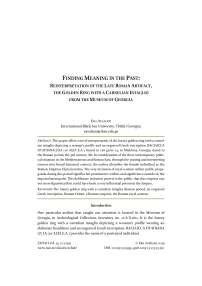Finding meaning in the past: reinterpretation of the late roman artifact, the golden ring with a carnelian intaglio from the museum of Georgia
Автор: Avaliani Eka
Журнал: Schole. Философское антиковедение и классическая традиция @classics-nsu-schole
Рубрика: Статьи
Статья в выпуске: 2 т.13, 2019 года.
Бесплатный доступ
This paper offers a novel interpretation of the luxury golden ring with a carnelian intaglio depicting a woman's profile and an engraved Greek inscription, ΒΑCIΛICCΑ ΟΥΛΠIAΝΑ(Ζ)IA (or AΣIA E.A.), found in cist grave 14, in Mtskheta, Georgia, dated to the Roman period, the 3rd century AD. In consideration of the then contemporary political situation in the Mediterranean and Roman East, through the putting and interpreting sources into broad historical context, the author identifies the female individual as the Roman Empress Ulpia Severina. The very inclusion of royal woman within public propaganda during this period signifies her prominence within, and significance outside of, the imperial metropolis. This deliberate inclusion proved to the public that this empress was not mere figurehead but could have been a very influential person in the Empire.
The luxury golden ring with a carnelian intaglio, an engraved greek inscription, roman orient, a roman empress, the roman royal woman
Короткий адрес: https://sciup.org/147215826
IDR: 147215826 | DOI: 10.25205/1995-4328-2019-13-2-503-512
Список литературы Finding meaning in the past: reinterpretation of the late roman artifact, the golden ring with a carnelian intaglio from the museum of Georgia
- https://nsu.ru/classics/schole/13/13-2-avaliani.pdf
- Accame, S. (1946) Il dominio Romano in Grecia dalla Guerra Acaica ad Augusto. Rome.
- Alcock, S. E. (1993) Graecia Capta: The Landscapes of Roman Greece. Cambridge.
- Apakidze, A., Kipiani, G., Nikolaishvili, V. (2004) "A Rich Burial from Mtskheta (Caucasian Iberia)", G. R. Tsetskladze, ed. Ancient West and East 3(1). Leiden and Boston, 104-123.
- Bouras, C. (2016) "The Geography of Connections: A Harbour Network in the Aegean Sea during the Roman Imperial Period?" K. Höghammar, B. Alroth and A. Lindhagen, eds. Ancient Ports, the Geography of Connections. Uppsala, 202-223.
- Budin, S. L. (2016) Artemis. London.
- Butcher, K. (2003) Roman Syria and the Near East. Los Angeles: Getty Publications.
- Demandt, A. (1998) Geschichte der Spätantike Das Römische Reich von Diocletian bis Justinian 284-565 n. Chr. München.
- Erskine, A. (1991) "Augustus and Rhodes", Zeitschrift für Papyrologie und Epigraphik 88, 271-275.
- Étienne, R. (1990) Ténos II. Ténos et les Cyclades du milieu du IVe siècle av. J.-C au milieu du Ille siècle ap. J.-C. Paris.
- Kauchtschischwili, T. (2003) "Neuentdeckte Gegenstände mit Griechischen Inschriften aus Mzcheta", R. Gordeziani, ed. Phasis 5-6, Institute of Classical Philology, Byzantine and Modern Greek Studies, Iv. Javakhishvili Tbilisi State University.Tbilisi, 136-142.
- Millar, F. (1966) "The Emperor, the Senate and the Provinces", The Journal of Roman Studies 56, 156-166.
- Radke, G. (1956) "Praeses", Realencyclopädie der Classischen Altertumswissenschaft. Supplementband VIII, Achaios-Valerius. col. 598-614.
- Ricciardi, R. (2007) Where Did All the Women Go: The Archaeology of the Soldier Empresses. Doctoral Thesis, University of Cincinnati. Cincinnati.
- Şare, T. (2011) Dress and Identity in the art of Western Anatolia: The Seventh through Fourth Centuries BCE. Doctoral Thesis, State University of New Jersey. New Brunswick.
- Suny, R. G. (1994) The Making of the Georgian Nation. Indianapolis.
- Tracene, H. (2011) The Visual Representation of Livia on the Coins of the Roman Empire. Doctoral Thesis, University of Albert. Edmonton, Alberta.
- Watson, A. (2003) Aurelian and the Third Century. London and New York.
- Weinstock, S. (1958) "Victoria", RE Pauly-Wissowa, Real Encyclopädie der klassischen Altertumswissenschaft 8. A2, 2501-42.


